Are you looking for a new addition to your indoor plant collection? If so, check out our list of 36 Maranta varieties below.
They are known for their stunning foliage patterns, ranging from deep green with purple spots to silvery blue leaves with cream variegation.
We have curated a list of prayer plants for you to explore, including the classic Green Prayer Plant, the magical black prayer plant, the vibrant Red Prayer Plant, and the stunning Silver Feather Maranta.
We researched each plant’s unique characteristics, including its foliage patterns, growth habits, and care requirements.
Maranta Plant
Marantas, known as prayer plants, are popular indoor plants for their beautiful foliage patterns and slow-growing nature.
They are called prayer plants because their leaves fold up at night, resembling praying hands.
The Maranta plant belongs to the Marantaceae family and is closely related to the Calathea genus.
These plants are native to South and Central America, Bermuda, and Southeast Brazil.
They have oval or lance-shaped leaves with purple markings or purple spots on green foliage. Some varieties have silver or silvery-blue leaves with cream variegation.
The red maranta has dark green leaves with bright red veins and a yellow center. Rabbit’s tracks maranta has light green leaves with dark green spots along the edges.
The silver feather maranta has blackish-green leaves with light blue veins.
Maranta plants are excellent for hanging baskets or as a standalone plant, with some varieties like the Maranta arundinacea growing up to 45cm tall.
Some varieties have roots that can be eaten or used to cook the starch. Other varieties have leaves that can make tea or medicine for sore throats and coughs.
With so many prayer plant varieties, there is a Maranta type for every indoor plant enthusiast.
Types of Maranta Plants
Find the perfect maranta for your indoor garden from these 36 varieties;
1. Maranta leuconeura (Prayer Plant)
Maranta leuconeura, commonly called the prayer plant, belongs to the Marantaceae family, including the Calathea genus.
The plant has oval, lance-shaped leaves with purple markings that fold up at night, resembling praying hands.
This unique characteristic makes it an excellent conversation starter for your guests. The plant prefers indirect sunlight, as too much light can cause the leaves to turn brown.
It needs moist soil, and distilled water is the best option for watering. With proper care, the plant can grow up to 45cm tall, with a two-foot spread.
Its dark green foliage patterns come in several shades, including variegated cream and silvery blue leaves.
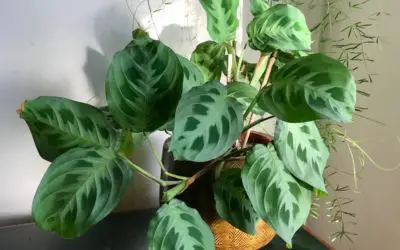
2. Maranta leuconeura ‘Kerchoveana’ (Rabbit’s Foot Plant)
Maranta leuconeura’ Kerchoveana’, or Rabbit’s Foot Plant, will add a unique touch to any space.
This Maranta variety has oval-shaped leaves that are dark green with purple markings on the top and burgundy-colored undersides.
The leaves have a distinctive pattern that resembles a rabbit’s paw, giving it its common name. Slow-growing, it can reach up to 30cm in height and has a two-foot spread.
Maranta leuconeura thrives in indirect light, perfect for hanging baskets or as a tabletop centerpiece.
Keep its soil moist but not waterlogged, and use distilled water to avoid leaf damage. With enough light, the younger leaves will remain a beautiful lemon-lime color.
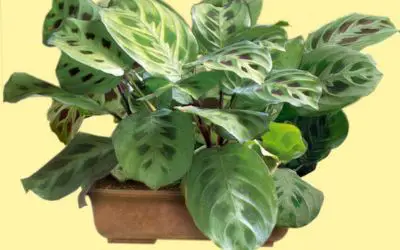
3. Maranta leuconeura ‘Erythroneura’ (Herringbone Plant)
This prayer plant has dark green leaves with a bright green central zone and red veins that form a herringbone pattern.
The underside of the leaves is purple-green, adding more contrast and beauty to this plant.
The Herringbone Plant is native to Brazil and prefers warm, humid, and shady conditions. It can grow up to 30cm tall and wide, ideal for hanging baskets or pots.
It does not need much fertilizer or pruning but requires regular watering and well-drained soil.
It rarely blooms indoors, but its attractive leaves are enough to make it a showstopper. The Herringbone Plant is easy to care for and will reward you with its gorgeous foliage all year round.
4. Maranta leuconeura ‘Fascinator’ (Green Prayer Plant)
The green prayer plant’s leaves are stunning, with bright red veins, dark green markings, and lime green splotches along the midrib.
It will brighten up any room with its vibrant leaves and charming personality.
To grow the green prayer plant successfully indoors, you must mimic its natural environment as much as possible.
Keep it out of direct sunlight, and water it regularly with distilled water, filtered water, or rainwater, as it’s sensitive to chemicals in tap water.
The green prayer plant is not only beautiful but also easy to propagate. You can chop it and place the root stem cuttings in water or soil when repotting.
5. Maranta leuconeura ‘Kim’ (Kim prayer plant)
Maranta leuconeura ‘Kim’ is known as the Kim or Beauty Kim prayer plant. It belongs to the genus Maranta. The plant has oval-shaped leaves that are velvety to the touch.
The leaves have varying shades of green, with purple spots and a cream-white streak along the midrib.
The undersides of the leaves are purple-red, adding more contrast and interest. The plant can grow up to 30cm tall and wide, ideal for shelves, desks, or hanging baskets.
Maranta leuconeura ‘Kim’ is a beautiful and easy-to-grow prayer plant that will add color and charm to any indoor space.
With its vibrant and patterned leaves that move throughout the day and night, this plant will surely catch your eye and make you smile.
6. Maranta arundinacea ‘Variegata’ (Variegated Arrowroot Plant)
Maranta arundinacea, ‘Variegata,’ is also known as the variegated arrowroot plant. This stunning plant has oval-shaped leaves with green and white stripes that fold up at night.
It can grow up to 30 cm tall and spread out to form a lush carpet of foliage. It also produces small white flowers in spring and summer.
Variegated arrowroot plants are not only beautiful but also useful. The roots are edible and can be used to make starch or flour.
7. Maranta leuconeura ‘Silver Band’ (Silver Band Prayer Plant)
It is a beautiful variety of prayer plants with a broad band of silver down the middle of each leaf and symmetrical silver veins.
The leaves are matte green and have a ribbed texture that adds to their charm.
Maranta leuconeura’ Silver Band’ prefers bright indirect light, moderate humidity, and moist but well-drained soil.
It can grow up to 20cm tall and wide, ideal for small spaces or hanging baskets.
The benefit of growing Silver Band lies in its attractiveness and air purification property. It can remove toxins such as formaldehyde and benzene.
It is also non-toxic to pets and children, so you can enjoy its beauty without worry.
8. Maranta leuconeura ‘Marisela’ (Marisela Prayer Plant)
Marisela is one of the most sought-after prayer plants due to its unique coloration and pattern.
It has light green leaves with darker green veins and striking red-purple undersides. The leaves are oblong-shaped and have a feather-like texture, which adds to the plant’s overall beauty.
It thrives best in bright indirect light, moist but well-drained soil, high humidity, and average household temperatures between 65°F (18°C) and 75°F (23°C).
It also benefits from regular fertilizing during spring and summer.
The Marisela Prayer Plant will impress any plant lover with its fascinating foliage and movement. Plus, it brings good luck and positive energy to your space.
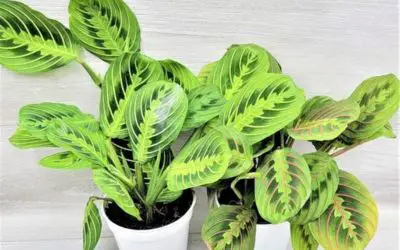
9. Maranta tricolor (Tricolor Prayer Plant)
Maranta tricolor has deep green, velvety leaves with yellow splotches down the midrib and arching red veins traveling to the leaf margins.
The leaves fold like praying hands at night, revealing their rosy pink undersides.
It is a slow-growing plant that can reach up to a foot in height indoors. It thrives best in warm, humid conditions with indirect sunlight and moist but well-drained soil.
Maranta tricolor is relatively simple to fertilize or prune but needs regular watering and protection from pests and diseases.
It rarely blooms indoors, but when it does, it produces white or pink flowers surrounded by orange-red bracts that hang above the foliage.
Maranta tricolor is a beautiful plant that will add a touch of exotic beauty and charm to your home. It is easy to grow and care for and will reward you with its colorful and dynamic foliage.
10. Maranta roseopicta (Red Prayer Plant)
Maranta roseopicta has large, oval-shaped leaves that are dark green with pink or red markings along the veins and edges.
The undersides of the leaves are purple-red, creating a striking contrast when they fold up at night.
The plant is non-toxic to pets, so you don’t have to worry about your furry friends nibbling it.
Another benefit is that it can purify the air by removing toxins such as formaldehyde and benzene. It can also add moisture to the air by transpiring water through its leaves.
11. Maranta leuconeura ‘Lemon Lime’ (Lemon Lime Prayer Plant)
Maranta leuconeura’ Lemon Lime’ has oval-shaped leaves that are dark green with bright lime-green stripes along the veins.
The leaves have a velvety texture and can grow up to 15cm long. The underside of the leaves is purple-red, adding more contrast and interest.
It would be best to water it regularly during the growing season (spring to summer), keeping the soil evenly moist but not wet.
You can check the moisture level by inserting your finger into the soil up to the second knuckle. If it feels dry, it is time to water.

12. Maranta leuconeura ‘Massangeana’ (Massangeana Prayer Plant)
This maranta plant has oval-shaped leaves that are mint green and marked with elegant black-green patches that create a striking contrast.
The leaves also have a silver midvein that adds sparkle to the plant.
The Massangeana prayer plant requires little attention and maintenance. It prefers bright, indirect, or filtered light.
Avoid direct sunlight, as it can scorch or fade the leaves. Water with lukewarm water and avoid cold or hard water that can damage the leaves.
13. Maranta leuconeura ‘Kerchoveana Minima’ (mini green prayer plant)
This plant has oval-shaped light green leaves with darker green patches on both sides of the central vein.
The leaves are about 6 cm long and 3 cm wide, making them smaller than other Maranta leuconeura. The undersides of its leaves are also light green.
The plant grows horizontally and forms dense clumps reaching up to 30 cm in height and width. It is easy to care for if you provide it with bright indirect light, moist but well-drained soil, high humidity, and moderate temperatures.
14. Maranta leuconeura ‘Kerchoviana Variegata’ (Variegated Rabbit’s Foot Plant)
Variegated Rabbit’s Foot Plant has oval-shaped leaves that are light green with white veins and dark green splotches on both sides of the midrib.
The underside of the leaves is silvery-green. The plant can grow up to 30cm tall and wide.
Avoid direct sunlight, as it can scorch or fade the leaves. Keep the soil moist but well-drained, and use soft, lukewarm water to avoid salt buildup.
You can mist the plant regularly or place it on a pebble tray to increase humidity. Feed it with a balanced fertilizer every two weeks during the growing season and reduce watering and fertilizing in winter.
You can report it yearly or twice in a well-draining potting mix with peat moss, loamy soil, and perlite or coarse sand.
Watch out for common pests like spider mites, mealybugs, or scale insects and treat them with insecticidal soap or neem oil.
15. Maranta leuconeura ‘Marisela’ (Marisela prayer plant)
This maranta leuconeura has bright green leaves with yellow veins and spots. The leaves are oval-shaped and have a wavy edge.
Marisela prayer plants prefer bright indirect light and moist but well-drained soil. The plant also enjoys high humidity and occasional misting.
You can prune them to keep them compact and bushy. They rarely flower indoors, but their leaves are enough to brighten up any space.
Marisela prayer plants are not toxic to pets or humans but may cause skin irritation to some people.
16. Maranta bicolor (Silver Feather Maranta)
The leaves of Maranta bicolor are oval-shaped and variegated with silver and green patterns that resemble brushstrokes.
The undersides of the leaves are dark red, creating a striking contrast. The leaves also have red veins that add more interest and texture.
Maranta bicolor is not prone to common pests or diseases that affect other houseplants.
However, it may be sensitive to chemicals in tap water, so it is better to use filtered or distilled water or rainwater to water it.
It is also easy to grow. Maranta bicolor only requires a little attention or maintenance to thrive.
It prefers bright but indirect light, moist but well-drained soil, and moderate temperatures. It does not need frequent fertilizing or pruning either.
17. Maranta amabilis (Red Vein Prayer Plant)
Maranta amabilis has oval, light green leaves intricately marked with dark green strokes along the midrib, resembling a fishbone. The undersides of the leaves are often dark red.
Red Vein Prayer Plant can grow up to 40 centimeters tall and wide and has shallow roots. It can be repotted in spring if rootbound, using a soil-based compost.
It rarely produces flowers when grown indoors, but if they appear, they are small and white.
18. Maranta fasciata (Zebra Plant)
The Zebra Plant is a slow-growing succulent that can reach up to 15cm tall and wide. It is ideal for small pots and containers; you can place it on windowsills, shelves, desks, or tables.
The Zebra Plant gets its name from the white stripes contrasting with the dark green leaves.
These stripes give it a zebra-like appearance that adds interest and texture to any space. The leaves are also waxy and triangular-shaped, forming a rosette pattern that grows upward.
It prefers indirect light or partial shade, as direct sunlight can scorch its leaves. It also likes moist but well-drained soil. You should avoid overwatering it as it can cause root rot.
19. Maranta roseopicta ‘Dottie’ (Dottie Prayer Plant)
Dottie Prayer Plant has dark green, almost black leaves with bright pink variegation contrasting beautifully with its purple undersides.
It is a low-maintenance plant that can thrive in medium to low-light conditions and prefers high humidity and moist soil.
The Dottie Prayer Plant can brighten any room with its vibrant colors and graceful movement.
It is also easy to care for. You can use a moisture meter to check when your plant needs watering and mist it regularly or place it near a humidifier to keep it happy.
The plant is also an air purifier that can remove toxins from your indoor environment. Therefore, it can create a soothing atmosphere to help you relax and sleep better.
20. Maranta roseopicta ‘Medallion’ (Medallion Prayer Plant)
Maranta roseopicta’ Medallion’ has large oval-shaped leaves that are dark green with light green patterns and purple undersides.
The leaves have a velvety texture and a glossy shine, making them look like an artist has painted them.
The plant can grow up to 30cm tall and wide, ideal for windowsills, tabletops, or humid spaces like bathrooms.
Maranta roseopicta’ Medallion’ is native to Brazil, where it grows in tropical forests under shady conditions.
Therefore, it prefers medium to low light indoors, away from direct sunlight that can scorch its leaves. It also likes high humidity and moist but well-drained soil.
21. Maranta roseopicta ‘Koningin Julianalaan’ (Queen Juliana Prayer Plant)
The Queen Juliana Prayer Plant has stunning foliage that features deep green leaves with a fuchsia midrib and a ring of feathered pink markings near the edges.
The underside of the leaves is deep purple, creating a striking contrast.
Queen Juliana Prayer Plant can reach up to 30cm in height and width. It prefers bright indirect light and high humidity, ideal for windowsills, desktops, or humid spaces.
It also likes moist but well-drained soil that is slightly acidic.
However, you should avoid using tap water to water it, as it can be sensitive to salts and impurities that can cause leaf burn. Instead, use filtered or distilled water for the best results.
22. Maranta roseopicta ‘Triostar’ (Triostar Prayer Plant)
The Triostar Prayer Plant has spectacular variegated, creamy white and green leaves with pink edging and purple undersides.
The Triostar Prayer Plant is native to the tropical rainforests of South America, where it grows in warm and humid conditions under the shade of larger plants.
To keep this plant happy indoors, you must provide it with similar situations to keep this plant happy indoors.
Repot your plant every year or two when it becomes root bound or outgrows its pot. Use a well-draining potting mix that is light and airy, such as one part peat moss and one part perlite.
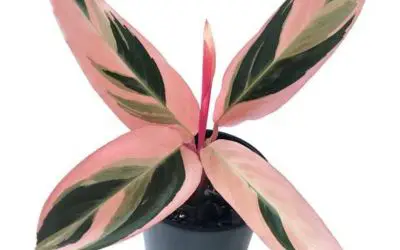
23. Maranta roseopicta ‘Erythroneura’ (Red-Veined Prayer Plant)
This maranta variety has oval-shaped leaves that are olive-green with striking red veins in a zigzag pattern. The leaves also have a pale green center and a lighter underside.
The Red-Veined Prayer Plant rarely blooms indoors, but its foliage is attractive enough. It can grow up to 38cm tall and wide, ideal for hanging baskets or pots on shelves or tables.
24. Maranta bicolor ‘Rubra’ (Red-Veined Silver Feather Maranta)
Maranta bicolor ‘Rubra’ has oval-shaped and velvety leaves, and it can grow up to 17cm long and 7cm wide. It is one of the rarer varieties of Maranta that is occasionally seen in the trade.
The leaves are dark green with light green blotches between the midrib and margin and have striking red veins that radiate from the center.
The underside of the leaves is purple, adding more contrast and interest.
25. Maranta hahnii (Hahn’s Prayer Plant)
Maranta hahnii (Hahn’s prayer plant) is a stunning houseplant with oval, variegated leaves that fold up at night like praying hands.
It belongs to the Maranta genus, which includes several other types of prayer plants.
Maranta hahnii has deep green leaves with yellow splotches along the midrib and red veins that curve toward the leaf margins.
It grows slowly and can reach a foot in height and width. Maranta hahnii is an eye-catching and easy-to-care-for plant that adds tropical flair to your home or office.
26. Maranta hahnii ‘Green’ (Green Hahn’s Prayer Plant)
This rare and beautiful variety of maranta has bright green leaves with dark green patches on either side of the central vein.
The leaves also have a velvety texture and fold up at night like praying hands.
Maranta hahnii ‘Green’ is a low-growing and spreading plant that can reach up to 30cm in height and width.
It makes a great hanging or shelf plant as it cascades over the edges of the pot. It rarely blooms indoors, but its foliage is attractive enough to compensate for the lack of flowers.
Maranta hahnii’ Green’ is uncommon in nurseries or online shops, so you might have to search for it or order it from specialized growers.
27. Maranta hahnii ‘Leuconeura’ (Leuconeura Hahn’s Prayer Plant)
Maranta hahnii’ Leuconeura’ has oval-shaped leaves that are dark green with light green veins and red spots.
The underside of the leaves is purple and red, adding more contrast and color to the plant. It grows up to 15cm tall and spreads horizontally, forming a dense mat of foliage.
This plant prefers bright indirect light, moist but well-drained soil, and high humidity. It does not tolerate direct sun, dry air, or cold temperatures.
It is also sensitive to fluoride and chlorine in tap water, so it is better to use filtered or distilled water for watering.
28. Maranta lutea (Yellow Maranta)
Maranta lutea is a caulescent plant with a stem above the ground. It can grow 4 meters tall, with several basals and one or two stem leaves.
The leaves are large, oval, and evergreen, measuring 150 cm long and 60 cm wide.
The leaf tip is broadly rounded or truncated, and the leaf margin is densely fringed with hairs. The upper surface of the leaf is green, while the lower surface is white and waxy.
Maranta lutea’s inflorescence has a spike of yellow flowers enclosed by a large yellow bract that resembles a cigar.
The flowers are small and inconspicuous, but the bract is showy and attractive.
29. Maranta pinnatipartita (Feather Maranta)
Feather maranta is a rare plant with dark green, heart-shaped leaves with yellow splotches along the midrib and red veins that extend to the edges.
The leaves also have deep cuts that make them look like feathers.
Feather maranta is an evergreen climber that can grow up to 6 feet indoors with proper support. It prefers bright but indirect light, moist but well-drained soil, and warm and humid conditions.
It does not bloom indoors, but its foliage is enough to add beauty and interest to any space.
Also read: monstera pinnatipartita care
30. Maranta ramosissima (Branched Maranta)
Maranta ramosissima has slender stems that branch out from the base, forming a dense clump of greenery.
The leaves are oval-shaped and have a glossy surface with dark green veins and spots. The flowers are small and white, but they are not very showy.
Branched Maranta is excellent for hanging baskets, containers, or ground covers in shady areas. It can also be grown indoors as a houseplant if it gets enough light and moisture.
31. Maranta tuberculata (Tubercle Maranta)
Maranta tuberculata is a less common species in cultivation, but it has some distinctive features that make it stand out.
It has oval, evergreen leaves that are dark green with light green veins and purple spots on both sides.
The leaf margins are wavy and sometimes have small tubercles or bumps. The flowers are white with purple markings on the staminodes.
32. Maranta affinis
Maranta affinis is native to Brazil and has oval-shaped leaves that are dark green with white veins and purple undersides.
The leaves fold up at night like praying hands, giving the plant its common name of prayer plant.
The flowers are small and white with purple spots and two large petal-like structures. It can be propagated by dividing the rhizomes or taking stem cuttings. It is not toxic to pets or humans.
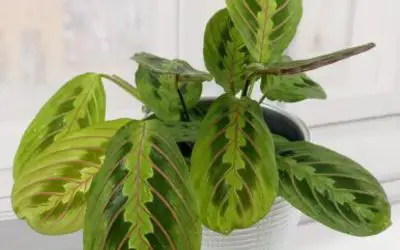
33. Maranta amplissima (Ample Maranta)
Maranta amplissima, or ample maranta. This plant has large, oval leaves that are dark green with light green veins and spots. The undersides of the leaves are purple-red.
Ample maranta can grow up to 30cm tall and wide, making it a good choice for hanging baskets or shelves.
With proper care, it will reward you with its stunning foliage and graceful movement for years to come.
34. Maranta galapagensis (Galapagos Maranta)
Maranta galapagensis, or Galapagos maranta. This rare species is native to the Galapagos Islands and has green leaves with white veins and purple spots. It also has pink flowers that bloom in clusters.
It makes a great addition to any indoor jungle or terrarium. However, Galapagos maranta is challenging to find in nurseries or online shops.
But if you get one, you must provide specific care to keep it happy and healthy.
35. Maranta recurvata (Recurved Maranta)
Maranta recurvata has oval-shaped leaves that are dark green with light green stripes along the veins. The undersides of the leaves are purple-red.
The leaves are attached to long stems that arch gracefully over the pot.
The flowers are not very showy compared to the foliage, but they charm this lovely plant. It is an excellent choice for hanging baskets or tabletops.
36. Maranta orbifolia
The Maranta orbifolia is also known as the round-leaf calathea or the prayer plant. The leaves are oval-shaped and have striking stripes of silver-gray and green that run across them.
The underside of the leaves is pale green, and the plant can grow up to a foot tall and wide indoors.
It grows best in bright indirect light, moist but well-drained soil, high humidity, and warm temperatures.
It does not tolerate direct sun, dry air, or cold drafts. It also needs regular fertilizing during the growing season and pruning to remove dead or damaged leaves.
Conclusion
We have discussed maranta leuconeura, kerchoveana, erythroneura, fascinator, Kim prayer plant, and maranta arundinacea.
They are a low-growing, spreading plant species native to Brazil and other tropical regions.
Marantas are stunning indoor plants that will add a touch of tropical flair to any home. Their striking foliage patterns and daily movement will captivate your attention and admiration.
